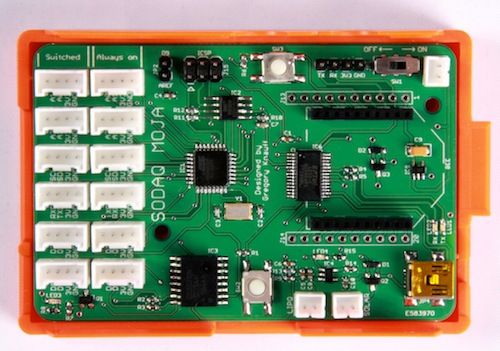What’s SODAQ?
Prototyping should be rapid. Putting projects together should be as easy as clicking together lego-like building blocks. SODAQ makes it so.
SODAQ is a multi-feature microprocessor board that lets you connect sensors and devices to the internet, quickly and with no fuss. It’s designed for connecting things efficiently, running off-grid with built-in, ready-to-go solar power:SOlar Data AcQuisition
Getting data off a device is only half the story – it needs to go somewhere. We designed the SODAQ system to be able to communicate from anywhere, with a GPRS module and all the control code for it included from the start.
It takes the Arduino prototyping concept, makes it simpler, and extends it. No breadboarding or soldering required, but with plenty of memory, sockets, solar panel and battery control, and extra features, all on one board.
The board has built in sockets for Grove modules; a realtime clock; extended flash memory; USB on-board; and the Bee socket can take any WiFi/RF/XBee or other compatible plugin for communications instead of our GPRS module.
All our hardware designs and software libraries will be made available in our GitHub: SODAQ Moja repository.
Beware Shark!
Our favourite project so far: using our first generation boards, we connected up research-grade sensors for an environmental monitoring system, tracking ecological factors for a WWF whale shark research project in the Indian Ocean. The GPRS part lets us transmit the data back in realtime, with utter reliability.
The scientists now get detailed environmental data, sent every hour from remote locations on little islands off the East African coast. They haven’t missed a single data record since installation in October 2012.
“Thank you … it is a beautiful, complete dataset – unusual for us, we are normally used to dealing with more gaps than observations!” – from the lead investigator.
The (early version) SODAQ board with its built-in ability to handle all the power/solar and GPRS communications, and easy plug in sockets for sensors, made this project really simple, and saved thousands of dollars compared to commercial data loggers / large solar panels / industrial modem set-ups. The results seem to be better too!
We’ve also already used it as the core to connect up weather, soil, and river monitoring for small subsistence farmers in cooperatives in East Africa, for big irrigation management on large commercial farms, and for a bunch of projects in the UK and Holland.
“It’s designed for connecting things efficiently, running off-grid with built-in, ready-to-go solar power. [That is why] we designed the SODAQ system (SOlar Data AcQuisition) to be able to communicate from anywhere, with a GPRS module and all the control code for it included from the start,” the SODAQ team wrote in a recent Kickstarter post.
“[There is] no breadboarding or soldering required. SODAQ [boasts] plenty of memory, sockets, solar panel, battery control and extra features – all on one board. [It is equipped with] built-in sockets for Grove modules; a real-time clock; extended flash memory; USB on-board and a Bee socket (WiFi/RF/XBee or compatible plugin).”
According to the SODAQ crew, early iterations of the board have already been deployed to various locations in Peru and Tanzania, where they are helping link weather stations, big commercial irrigation and school projects to the Internet. First-gen SODAQ boards have also been used to power an environmental monitoring system, tracking ecological factors for a WWF whale shark research project in the Indian Ocean.
“The (early version) SODAQ board with its built-in ability to handle all the power/solar/GPRS communications and easy plug in sockets for sensors made this project really simple. [It] saved thousands of dollars compared to commercial data loggers/large solar panels/industrial modem set-ups,” the SODAQ crew explained. ”We’ve also already used it as the core to connect up weather, soil and river monitoring for small subsistence farmers in cooperatives in East Africa, for big irrigation management on large commercial farms and for a bunch of projects in the UK and Holland.”
Key SODAQ specs include:
- ATmega328P MCU running at 3.3V and 8MHz.
- Power Supply by LiPo Battery (3.7V) (supplied LiPo: 1,000mAh) or USB Cable.
- Programming by USB cable (and ICSP header also included).
- Solar Charge controller & JST connector for solar panel up to 2.5W (supplied panel: 0.5W).
- Battery monitor.
- DS3231 real time clock and temperature sensor.
- 16 MBit data flash module (AT45DB).
- Micro USB connector.
- 12 Grove connectors connecting Digital, Analog and I2C pins.
- On/off switch.
- Active solar charge circuit and powered RTC clock – even when switch is in “off” position.
For more detail: SODAQ: a lego-like, plug-in, rapid prototyping board

